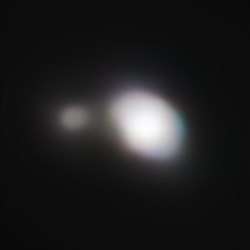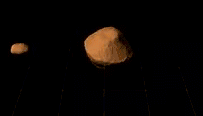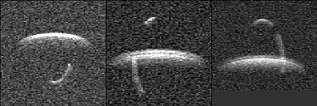66391 Moshup
66391 Moshup /ˈmɒʃʌp/, provisional designation 1999 KW4, is a binary asteroid, classified as a near-Earth object and potentially hazardous asteroid of the Aten group, approximately 1.3 kilometers in diameter. It was discovered on 20 May 1999, by Lincoln Near-Earth Asteroid Research (LINEAR) at the Lincoln Laboratory's Experimental Test Site in Socorro, New Mexico, United States.[3] It is also a Mercury-crosser and the closest known binary system to the Sun with a perihelion of just 0.2 AU.
 Moshup and its satellite Squannit imaged by the Very Large Telescope's SPHERE instrument[1] | |
| Discovery [2] | |
|---|---|
| Discovered by | LINEAR |
| Discovery site | Lincoln Lab's ETS |
| Discovery date | 20 May 1999 |
| Designations | |
| Pronunciation | /ˈmɒʃʌp/ |
Named after | Moshup (Maushop) (native American legend) |
| 1999 KW4 | |
| Aten · NEO · PHA [2][3] Mercury-crosser Venus-crosser | |
| Orbital characteristics [2] | |
| Epoch 4 September 2017 (JD 2458000.5) | |
| Uncertainty parameter 0 | |
| Observation arc | 19.01 yr (6,942 days) |
| Aphelion | 1.0845 AU |
| Perihelion | 0.2000 AU |
| 0.6422 AU | |
| Eccentricity | 0.6886 |
| 0.51 yr (188 days) | |
| 359.03° | |
| 1° 54m 54s / day | |
| Inclination | 38.884° |
| 244.91° | |
| 192.62° | |
| Known satellites | 1 (Squannit /ˈskwɒnɪt/) |
| Earth MOID | 0.0138 AU · 5.4 LD |
| Physical characteristics | |
| Dimensions | 1.532 × 1.495 × 1.347 km[4] |
Mean diameter | 1.317±0.040 km[4] |
| Mass | (2.49±0.054)×1012 kg[4] |
| 2.7650 h[5]p | |
| 0.26 (derived)[6] | |
| SMASS = S[2][6] V–I=0.85±0.01[7] V–R=0.44±0.02[7] V–I=0.65±0.03[7] | |
| 16.5[2][6] | |
Orbit
The asteroid orbits the Sun at a distance of 0.2–1.1 AU once every 6.18 months (188 days). Its orbit has an eccentricity of 0.69 and an inclination of 39° with respect to the ecliptic.[2] A first precovery was taken by 2MASS at the Fred Lawrence Whipple Observatory in 1998, extending the body's observation arc by one year prior to its official discovery observation at Socorro.[3]
As a potentially hazardous asteroid, it has an Earth minimum orbital intersection distance of 0.0138 AU (2,060,000 km) which corresponds to 5.4 lunar distances.[2] On 25 May 2036, it will pass 0.0155 AU (2,320,000 km) from Earth.[8]
Numbering and naming
This minor planet was numbered by the Minor Planet Center on 10 September 2003. It was named from Mohegan legend, after Moshup, a giant who lived in the coastal areas of New England. The asteroid's companion is named Squannit, after the wife of Moshup and a medicine woman of the Makiawisug (little people). The official naming citation was published by the Minor Planet Center on 27 August 2019 (M.P.C. 115894).[9]
Physical characteristics
In the SMASS classification, the asteroid a characterized as a stony S-type asteroid.[2]
Satellite

Moshup has a minor-planet moon orbiting it. The moon, named Squannit /ˈskwɒnɪt/ and designated S/2001 (66391) 1, is approximately 360 metres in diameter, and orbits its primary in every 16 hours at a mean-distance of 2.6 kilometers. The presence of a companion was suggested by photometric observations made by Pravec and Šarounová and was confirmed by radar observations from Arecibo observations and announced on 23 May 2001 (also see below).[5][10] Based on radar imaging, Squannit's dimensions are estimated to be 595 × 450 × 343 meters.[4]
Diameter and shape

According to radiometric observations from Arecibo Observatory, the asteroid has a mean diameter of 1.317 kilometers.[4] The observations were taken from May 21–23, 2001, by Lance A. M. Benner, Steven J. Ostro, Jon D. Giorgini, Raymond F. Jurgens, Jean-Luc Margot and Michael C. Nolan.[4]
The Collaborative Asteroid Lightcurve Link adopts a diameter of 1.3 kilometers and derives an albedo 0.26 with an absolute magnitude of 16.5.[6]
The shapes of the two bodies and their dynamics are complex.[11] With a dimension of approximately 1.42 × 1.36 × 1.18 kilometers for a simple triaxial ellipsoid, the asteroid has an oblate shape, which is dominated by an equatorial ridge at the body's potential-energy minimum. This bizarre property of the equatorial region means that it is close to breakup: raising a particle a meter above the surface would put it into orbit. As seen in the image at above right, the gravitational effects between the moon and the asteroid create a gigantic mountain extending in the equatorial plane around the entire asteroid. It was the first asteroid to be described as "muffin-shaped",[12] which is now understood to be a very common shape for asteroids in critical rotation,[13] including 101955 Bennu and 162173 Ryugu.
Lightcurves
During 19–27 June 2000, a rotational lightcurve of this asteroid was obtained from photometric observations by Petr Pravec and Lenka Šarounová at Ondřejov Observatory. Lightcurve analysis gave a rotation period of 2.7650 hours with a brightness variation of 0.12 magnitude (U=3).[5]
See also
- List of asteroid close approaches to Earth in 2019
- List of solar system objects by size
References
- "ESO contributes to protecting Earth from dangerous asteroids". European Southern Observatory. 3 June 2019. Retrieved 3 June 2019.
- "JPL Small-Body Database Browser: 66391 (1999 KW4)" (2017-05-31 last obs.). Jet Propulsion Laboratory. Retrieved 1 June 2017.
- "66391 (1999 KW4)". Minor Planet Center. Retrieved 30 March 2017.
- Ostro, Steven. J.; Margot, Jean-Luc; Benner, Lance A. M.; Giorgini, Jon D.; Scheeres, Daniel J.; Fahnestock, Eugene G.; et al. (November 2006). "Radar Imaging of Binary Near-Earth Asteroid (66391) 1999 KW4". Science. 314 (5803): 1276–1280. Bibcode:2006Sci...314.1276O. doi:10.1126/science.1133622. PMID 17038586. Retrieved 1 June 2017.
- Pravec, P.; Scheirich, P.; Kusnirák, P.; Sarounová, L.; Mottola, S.; Hahn, G.; et al. (March 2006). "Photometric survey of binary near-Earth asteroids". Icarus. 181 (1): 63–93. Bibcode:2006Icar..181...63P. doi:10.1016/j.icarus.2005.10.014. Retrieved 1 June 2017.
- "LCDB Data for (66391)". Asteroid Lightcurve Database (LCDB). Retrieved 1 June 2017.
- Carbognani, Albino (October 2019). "The Color Indices of the NEA (66391) 1999 KW4". The Minor Planet Bulletin. 46 (4): 444. Bibcode:2019MPBu...46..444C. ISSN 1052-8091.
- "JPL Close-Approach Data: 66391 (1999 KW4)" (2013-05-09 last obs (arc=14.9 yr)). Retrieved 6 April 2016.
- "MPC/MPO/MPS Archive". Minor Planet Center. Retrieved 24 February 2018.
- Johnston, Robert (20 October 2019). "(66391) Moshup and Squannit". Johnston's Archive. Retrieved 30 March 2017.
- NASA Jet Propulsion Laboratory Asteroid Radar Research Archived 2007-12-07 at the Wayback Machine, retrieved May 3, 2007
- CBS News - Scientist: Asteroid To Return In 2036,
- Jewitt, David; Weaver, Harold; Mutchler, Max; Li, Jing; Agarwal, Jessica; Larson, Stephen (2018). "The Nucleus of Active Asteroid 311P/(2013 P5) PANSTARRS". The Astronomical Journal. 155 (6): 231. arXiv:1804.05897. doi:10.3847/1538-3881/aabdee. ISSN 1538-3881.
External links
| Wikimedia Commons has media related to 66391 Moshup. |
- Margot, Jean-Luc, Radar observations of 1999 KW4 November 1999, retrieved July 2016
- Asteroids with Satellites, Robert Johnston, johnstonsarchive.net
- 1999 KW4 orbit and observations at IAU Minor Planet Center
- 66391 Moshup at NeoDyS-2, Near Earth Objects—Dynamic Site
- Ephemeris · Obs prediction · Orbital info · MOID · Proper elements · Obs info · Close · Physical info · NEOCC
- 66391 Moshup at the JPL Small-Body Database


